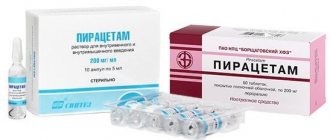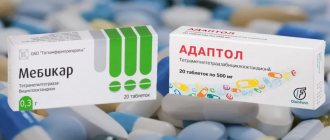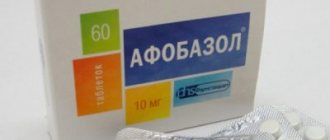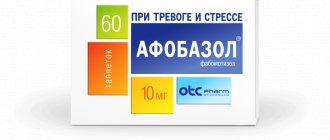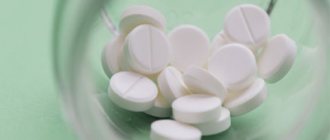In the modern world there are almost no unique substances; any category of objects is represented by a broad group. From an evolutionary point of view, the more different creatures in an ecosystem, the more resistant it is to adverse factors. In the environment of human interaction, the phenomenon when one product has many options, forms and manufacturers is called competition. Thanks to this, better representatives remain on the market, and the rest disappear.
Cortexin and Cerebrolysin are nootropics. Nootropics are medications that improve brain function and stimulate cognitive processes (learning, memory, thinking). They also protect neurons from damaging influences and promote faster recovery of central nervous system structures in neurological diseases.
pharmachologic effect
Cerebrolysin contains low molecular weight biologically active neuropeptides that penetrate the BBB and directly enter nerve cells.
The drug has an organ-specific multimodal effect on the brain, i.e. provides metabolic regulation, neuroprotection, functional neuromodulation and neurotrophic activity. Metabolic regulation:
The drug Cerebrolysin increases the efficiency of aerobic energy metabolism of the brain, improves intracellular protein synthesis in the developing and aging brain.
Neuroprotection:
the drug protects neurons from the damaging effects of lactic acidosis, prevents the formation of free radicals, increases survival and prevents the death of neurons under conditions of hypoxia and ischemia, and reduces the damaging neurotoxic effect of excitatory amino acids (glutamate).
Neurotrophic activity:
Cerebrolysin is the only nootropic peptidergic drug with proven neurotrophic activity similar to the action of natural neuronal growth factors (NGF), but manifested under conditions of peripheral administration.
Functional neuromodulation:
The drug has a positive effect in cases of cognitive impairment on memory processes.
Review of Cerebrolysin and Cortexin
Both drugs are nootropics with a neuroprotective effect, but they also have the following features:
- Cerebrolysin is a nootropic drug that is obtained from the brains of young animals, calves and pigs. Cerebrolysin is available as an injection solution. The active ingredient is Cerebrolysin protein concentrate.
The drug has a high level of protection of neurons from the effects of free radicals, and it also protects the brain from the death of neurons during the development of hypoxia.Neuronal protective properties are very important for the treatment of stroke caused by cerebral ischemia. In addition to its nootropic properties, the drug enhances the synthesis of transport molecules that are responsible for the delivery of glucose to tissues and increases the energy potential of cells.
- Cortexin is a polypeptide-based bioregulator that is obtained from the brain of young calves and pigs. The animal must be no older than 1 year. The drug is made in Russia. Cortexin has shown high effectiveness in patients with chronic cerebrovascular diseases.
In the complex therapeutic treatment of patients with dyscirculatory encephalopathy, the use of the drug Cortexin 100% improves the quality of life of patients with a positive result of therapy. The drug restores impaired cognitive-mnestic functions. The positive therapeutic effect persists for a long time after stopping the medication course with Cortexin.
Dosage
The drug is used parenterally. The dose and duration of use depend on the nature and severity of the disease, as well as the age of the patient. A single administration of the drug in a dose of up to 50 ml is possible, but a course of treatment is more preferable.
The recommended course of treatment is daily injections for 10-20 days.
| Indication | Dose |
| Acute conditions (ischemic stroke, traumatic brain injury, complications of neurosurgical operations) | from 10 ml to 50 ml |
| In the residual period of cerebral stroke and traumatic injury to the brain and spinal cord | from 5 ml to 50 ml |
| Psychoorganic syndrome and depression | from 5 ml to 30 ml |
| Alzheimer's disease, dementia of vascular and combined Alzheimer's-vascular origin | from 5 ml to 30 ml |
| In neuropediatric practice | 0.1-0.2 ml/kg body weight |
To increase the effectiveness of treatment, repeated courses can be carried out as long as the patient's condition improves as a result of treatment. After the first course, the frequency of injections can be reduced to 2 or 3 times a week.
Cerebrolysin is used parenterally in the form of intramuscular injections (up to 5 ml) and intravenous injections (up to 10 ml). The drug in a dose of 10 ml to 50 ml is recommended to be administered only through slow intravenous infusions after dilution with standard solutions for infusion. The duration of infusions ranges from 15 to 60 minutes.
Indications and contraindications
Cortexin is prescribed for the treatment of diseases associated with dysfunction of the central nervous system. The main indications for use are:
- cognitive impairment – decreased intellectual abilities, thinking and deterioration in memory quality;
encephalopathy;- asthenic syndrome;
- epileptic seizures;
- autonomic disorders;
- perinatal lesions of the central nervous system in infants from the moment of birth;
- cerebral palsy;
- deviations in the psychomotor development of children;
- disorders in the development of the speech apparatus of children;
- reduced ability of the student to remember educational material.
Cerebrolysin is prescribed for the following diseases:
- dementia;
- injury to spinal cord cells;
- head injuries and concussions;
- retardation in the intellectual development of children;
- Alzheimer's and Parkinson's disease;
- depression;
- absent-mindedness and impaired memory quality;
- pathologies of cerebrovascular type.
A contraindication to the use of Cortexin is the body's sensitivity to the active component and to additional substances in the composition.
Contraindications for the use of Cerebrolysin:
- pregnancy;
- epilepsy;
- sensitivity to components in the drug;
- kidney cell failure.
Side effects
The frequency of adverse reactions was determined in accordance with WHO recommendations: very often: (≥1/10); often: (from ≥1/100 to <1/10); uncommon (from ≥1/1000 to <1/100); rare (from ≥1/10,000 to <1/1000); very rare, including isolated reports (<1/10,000).
From the immune system:
very rarely - increased individual sensitivity, allergic reactions.
Mental disorders:
rarely - the expected activation effect is accompanied by agitation, manifested by aggressive behavior, confusion, and insomnia.
From the nervous system:
rarely - too rapid administration of the drug can lead to dizziness; very rarely - isolated cases of generalized epilepsy and one case of seizures were associated with Cerebrolysin.
From the cardiovascular system:
very rarely - too rapid administration of the drug can lead to increased heart rate and arrhythmia.
From the digestive system:
very rarely - dyspepsia, diarrhea, constipation, nausea, vomiting; rarely - loss of appetite.
For the skin and subcutaneous tissues:
very rarely - skin reactions; rarely - with excessively rapid administration, a feeling of heat, sweating, and itching may occur.
General disorders and disorders at the injection site:
very rarely - redness, itching, burning at the injection site, pain in the neck, head and limbs, fever, mild back pain, shortness of breath, chills, collapsing state.
One study reported an association between rare use (>1/10,000 to <1/1,000) with hyperventilation, hypertension, hypotension, fatigue, tremor, possible depression, apathy and/or somnolence, and flu-like symptoms. (cold, cough, respiratory tract infections).
Since Cerebrolysin is used mainly in elderly patients, the above symptoms of diseases are typical for this age group and often also occur without taking the drug.
It should be noted that some undesirable effects (excitement, arterial hypertension, arterial hypotension, lethargy, tremor, depression, apathy, dizziness, headache, shortness of breath, diarrhea, nausea) were identified during clinical studies and occurred equally in patients treated with Cerebrolysin and in patients in the placebo group.
If any of the side effects indicated in the instructions are aggravated or any other side effects not specified in the instructions are noted, the patient should inform the attending physician.
Notification in case of suspected side effects
It is important to report side effects after drug approval to ensure ongoing monitoring of the drug's risk-benefit profile. Healthcare professionals are asked to report all cases of adverse reactions observed with the drug through national adverse reaction reporting systems and/or to the company's representative office.
Side effects
It should be noted that the following reactions may occur in rare cases following the administration of Cerebrolysin:
- Feeling hot.
- Increased sweating.
- Dizziness.
- Heart rhythm disturbances.
- Nausea and vomiting.
- Constipation and diarrhea.
- Arterial hypo- and hypertension.
- Feeling tired.
- Depression, apathy.
- Increased excitability, manifestation of aggression.
- Convulsive seizures.
- Allergic reactions.
No adverse reactions were detected when using Cortexin.
Drug interactions
Taking into account the pharmacological profile of the drug Cerebrolysin, special attention should be paid to possible additive effects when co-administered with antidepressants or MAO inhibitors. In such cases, it is recommended to reduce the dose of the antidepressant. The use of Cerebrolysin in high doses (30-40 ml) in combination with MAO inhibitors in high doses can cause an increase in blood pressure.
Cerebrolysin and balanced solutions of amino acids should not be mixed in the same solution for infusion.
Cerebrolysin is incompatible with solutions containing lipids and with solutions that change the pH of the medium (5.0-8.0).
Key differences and effectiveness
The drugs are made from structural compounds of the brain of livestock, so there is no significant difference between them, but there are some features of administration:
- Cerebrolysin is the only nootropic drug with neurotrophic activity. The medication ensures and supports the vital activity of brain cells, activates their development and growth.
Cortexin has a positive effect on the restoration of electrical brain activity.- Cerebrolysin is actively used in the therapeutic treatment of ischemic strokes, spinal cord cell injury, for the treatment of depression, autism in children, and childhood enuresis.
- Cortexin is effective for improving memory, concentration, attentiveness and thinking, as well as for the treatment of such pathologies: encephalopathy of various etiologies, epilepsy, infectious encephalitis, cerebral palsy.
Both medications are not prescribed during pregnancy and breastfeeding due to the development of allergies and its consequences.
special instructions
If injections are performed too quickly, a feeling of heat, sweating, and dizziness may occur. Therefore, the drug should be administered slowly.
The compatibility of the drug has been tested and confirmed (within 24 hours at room temperature and light) with the following standard solutions for infusion: 0.9% sodium chloride solution, Ringer's solution, 5% dextrose (glucose) solution.
The simultaneous use of Cerebrolysin with vitamins and drugs that improve cardiac circulation is allowed, but these drugs should not be mixed in the same syringe with Cerebrolysin.
Only clear Cerebrolysin solution should be used and only once.
Impact on the ability to drive vehicles and operate machinery
Clinical studies have shown that Cerebrolysin does not affect the ability to drive vehicles and use machinery.
The principle of action of the drugs
Cerebrolysin and Cortexin have the same effects on the body. Highlight:
- nootropic effect - the functional responsibilities of brain cells improve - concentration and attention increase, memory and intellectual abilities improve, neurons become more resistant to stressful situations;
neuroprotective property – active protection of neurons from the effects of free radicals, glutamate molecules, toxins, calcium ions;- antioxidant effects on the body - inhibit lipid oxidation, which helps restore lipid balance, increase the survival of neuron cells in stress situations or during organ hypoxia;
- tissue-regenerating properties - activate metabolic processes in neurons, improve metabolism in the peripheral nervous system, increase the functioning of all parts of the brain.
Cerebrolysin and Cortexin are available in pharmacies without a prescription, but do not forget that all nootropic drugs are not intended for self-medication. These medications should be taken only as prescribed by a doctor.
Release form, composition and packaging
Injection
yellowish-brown, transparent.
| 1 ml | |
| Cerebrolysin concentrate (a complex of peptides* obtained from pig brain) | 215.2 mg |
* molecular weight not more than 10,000 daltons.
Excipients:
sodium hydroxide, water d/i.
- 1 ml - brown glass ampoules (10) - contour cell packaging (1) - cardboard packs.
- 2 ml - brown glass ampoules (10) - contour cell packaging (1) - cardboard packs.
- 5 ml - brown glass ampoules (5) - contour cell packaging (1) - cardboard packs.
- 10 ml - brown glass ampoules (5) - contour cell packaging (1) - cardboard packs.
- 20 ml - brown glass ampoules (5) - contour cell packaging (1) - cardboard packs.
- 30 ml - brown glass bottles (1) - cardboard packs.
- 30 ml - brown glass bottles (5) - cardboard packs.
What is the difference between Cerebrolysin and Cortexin?
There are no significant differences regarding the main active ingredient of these drugs. Both drugs are made from the brain structures of livestock and have a high degree of biological safety and sterility.
The country of manufacture of Cortexin is Russia, the manufacturer is the Geropharm group of companies. Cerebrolysin is produced by the Austrian company Ever Neuro Pharma with direct production in Germany. Both companies are reputable representatives of the pharmaceutical industry with a good reputation.
Cortexin contains Glycine, which is also a nootropic agent, as part of its additional substances. It belongs to the group of neuroamino acids. It has an “inhibiting” effect on neurons and improves signal transmission between brain cells. Helps improve mental performance and has a mild calming effect on the nervous system.
It is important that Cerebrolysin has a fairly extensive list of side effects, from simple redness at the injection site to a seizure. Although they are rare, it is imperative to take this feature into account, especially when prescribing to infants.
When using Cerebrolysin, some mothers complain of changes in the child's behavior. They say that children become disobedient and aggressive. This could presumably be due to the activating effect of the drug on the nervous system.
The instructions for use of Cortexin indicate that the only side effects noted are individual intolerance to the components of the drug.
What is more effective: Cortexin or Cerebrolysin?
As the experience of using both drugs shows, no significant clinical effects of these drugs have been noted. The effect of the medicine in each specific case is difficult to predict. It all depends on the extent and nature of the brain damage and previous therapy.
Based on the properties of the drugs, we can say that, for example, in a child with hypoxic brain damage, Cerebrolysin will have a greater effect. And in a child with convulsive readiness or epilepsy, it would be more advisable to use Cortexin. Therefore, the difference when taking one drug or another will be leveled depending on the effect on the nervous system that the doctor wants to achieve by prescribing these drugs.
Features of the use of drugs
Both drugs are available only in forms for parenteral administration. In this case, Cerebrolysin can be administered not only intramuscularly, but also intravenously.
Cortexin is available in vials with lyophilisate; before administration, it must be diluted in a solvent. Cerebrolysin is a ready-made solution and requires additional dilution only for intravenous use. The use of a ready-made solution is more convenient and safer in terms of the development of complications associated with the administration technique and microbial contamination of solutions.
Considering the positive effects of the drugs, the question arises: is it possible to use Cerebrolysin and Cortexin simultaneously? Theoretically, the drugs are compatible for use at the same time, but not in the same syringe.
But the use of drugs from the same group with a similar mechanism of action, especially in the form of injections, is inappropriate. And in some cases, the prescription of several drugs leads to polypharmacy, which is unacceptable in pediatric practice.
In the annotation to the drugs there is no indication of the potentiating effect when they are administered together, but the likelihood of adverse reactions increases.
An effective and acceptable option would be to inject Cerebrolysin after Cortexin if there are indications for a second course of treatment with nootropic drugs.
Having studied the question of how Cerebrolysin differs from Cortexin, you can understand which drug to choose to treat your baby. It is worth noting that the final decision on prescribing a particular medication remains with the attending physician. Only reasonable use of medications can bring the desired effect.
Valentina Ignasheva, pediatrician, especially for Mirmam.pro
Is it possible to use Cortexin and Ceraxon at the same time?
Ceraxon, like many of the above drugs, is a nootropic. However, its mechanism of action is completely different. Ceraxon is a precursor substance to fats, from which the membranes of cells, including nerve cells, are built. Due to this property, the use of this drug reduces the damaging effects on nerve cells and helps accelerate their recovery.
With the simultaneous use of Cortexin and Ceraxon, the overall positive effect is enhanced.
Recently, many analogues of Ceraxon have appeared, including Recognan, which has the same effect, but is more affordable. When used together with Cortexin, the effect is also enhanced.
